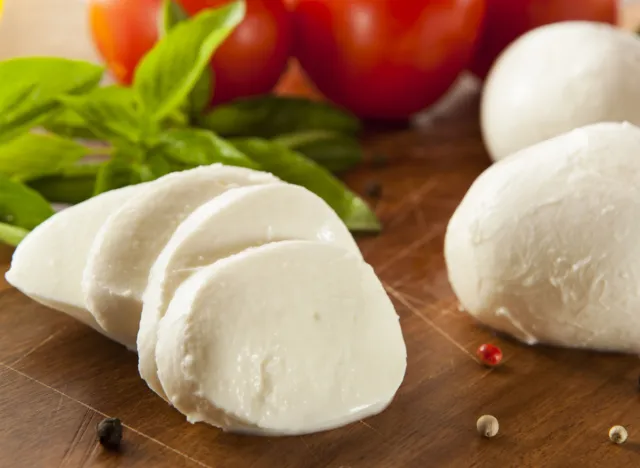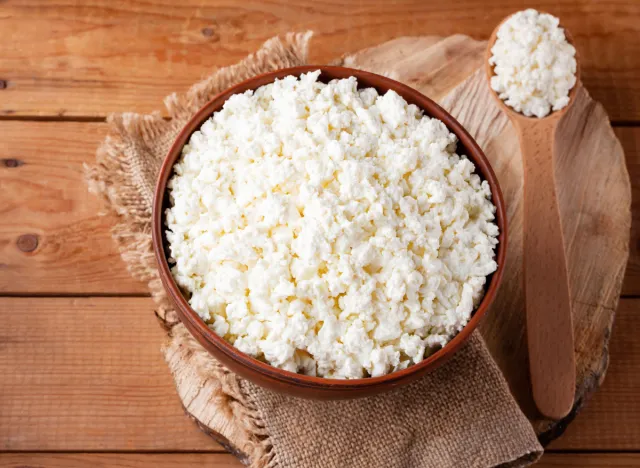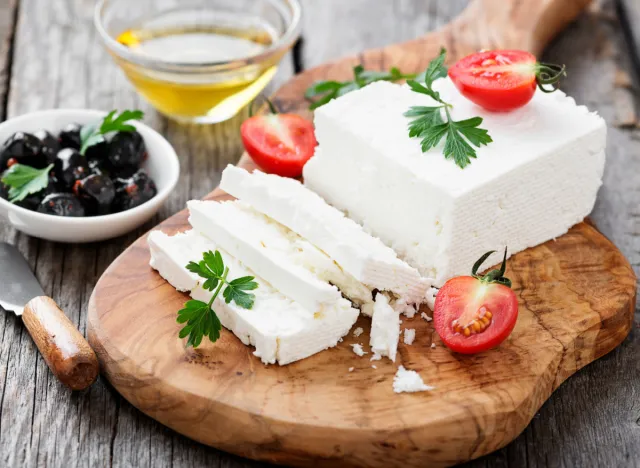5 Healthiest Cheeses You Can Eat With High Cholesterol

You've probably heard the motto, "Everything in moderation." Of course, this applies to all foods and (unfortunately) includes cheese. As a dietitian, a member of a family that owned a cheese store in New York City, and a wholehearted cheese lover, I understand that it can be hard to resist this beloved dairy food. However, since most cheeses are higher in saturated fat and sodium, they may not be the best choice for those managing high cholesterol.
According to the Centers for Disease Control and Prevention, about one in 10 Americans has high cholesterol. This common condition can lead to serious health concerns, including an increased risk for heart disease and stroke. Still, having high cholesterol doesn't mean that cheese should be off your menu.
In This Article:
- The Link Between Cheese and Cholesterol
- Can You Eat Cheese When You Have High Cholesterol?
- 5 Healthiest Cheeses for People with High Cholesterol
The Link Between Cheese and Cholesterol
Cholesterol, a fat-like substance essential for certain bodily functions, is present in every cell of your body. While your body needs cholesterol, too much cholesterol—particularly low-density lipoprotein (LDL), often referred to as "bad" cholesterol—can raise the risk of heart disease. Lifestyle factors, such as diet, inactivity, and genetics, all play a role in cholesterol levels, especially when it comes to foods high in saturated fat, like cheese.
Saturated fat is known to increase LDL cholesterol levels. Therefore, the Dietary Guidelines for Americans recommend keeping saturated fat intake below 10% of daily calories, or about 20 grams per day. Cheese also contains dietary cholesterol, but a comprehensive 2022 review published in the journal Nutrients, found no direct link between dietary cholesterol intake and blood cholesterol levels. While previous federal guidelines suggested a daily cap of 300 milligrams, the latest advice is to keep dietary cholesterol "as low as possible" without compromising nutritional balance.
Because foods high in saturated fat, like cheese, are also sources of dietary cholesterol, choosing low-fat cheese varieties can be a smart move for managing cholesterol.
Can You Eat Cheese When You Have High Cholesterol?
Many cheeses, such as Parmesan or blue cheese, tend to be higher in fat and cholesterol per ounce. The good news is that these cheeses are also highly flavorful, so a small amount—like a tablespoon of shredded or crumbled cheese—is all you need to up the "wow" factor of your dish.
For those looking to enjoy cheese more frequently while managing cholesterol, there are low-fat options available that dietitians recommend. Below, we share five cheeses that are better suited for those watching their cholesterol intake, as well as some tips for enjoying them in a heart-healthy way.
For additional heart-smart options, check out our list of 15 Heart-Healthy Breakfast Recipes To Fuel Your Morning.
5 Healthiest Cheeses for People with High Cholesterol
Part-Skim Mozzarella

Calories: 70
Fat: 4.5 g (Saturated Fat: 3 g)
Sodium: 175 mg
Cholesterol: 18 mg
Carbs: <1 g (Fiber: 0 g, Sugar: 0 g)
Protein: 7 g
"I always tell my clients of all ages that cheese is an amazing additive to the diet because it has protein, which helps build muscle mass, and calcium and vitamin D helps build and maintain bones through the lifespan," explains Jim White, RDN, ACSM EX-P, owner of Jim White Fitness and Nutrition Studios.
White's go-to cheese is mozzarella, which is low in saturated fat, with only 3 grams of it. Best of all, mozzarella only contains 18 milligrams of cholesterol, which is especially low compared to many other types of cheese.
Cheryl Mussatto MS, RD, LD, a clinical dietitian at Cotton O'Neil Cardiac Rehab in Topeka, KS, and author of The Nourished Brain, also loves mozzarella cheese—but prefers to opt for the fresh, part-skim kind.
Mussatto adds that she loves her mozzarella in a Caprese salad as well as in a spinach and cheese frittata.
Cottage Cheese

Calories: 80
Fat: 1 g (Saturated Fat: 0.5 g)
Sodium: 460 mg
Cholesterol: 5 mg
Carbs: 3 g (Fiber: 0 g, Sugar: 3 g)
Protein: 14 g
"Cottage cheese can be a great choice for cardiovascular health because it is high in protein and lower in fat," explains Amanda Sauceda, MS, RD, owner of The Mindful Gut, LLC.
Sauceda also recommends choosing cultured cottage cheese to get the benefit of live, active cultures for your gut microbiome, which research suggests is linked to heart health.
Feta

Calories: 75
Fat: 6 g (Saturated Fat: 3.5 g)
Sodium: 320 mg
Cholesterol: 25 mg
Carbs: 1 g (Fiber: 0 g, Sugar: 0 g)
Protein: 4 g
Leslie Bonci, MPH, RDN, CSSD, LDN, FAND, owner of Active Eating Advice by Leslie Bonci, recommends feta cheese with "only 25 milligrams of cholesterol per ounce and lower in saturated fat (3.5 grams) compared to most cheeses." Plus, Bonci says that feta's rich taste means a little goes a long way; you can use less of it overall in your dishes, but still enjoy a fabulous flavor to savor.
Perk up salads with crumbled feta, pair with fruit, or add some produce to the plate by mixing feta in with fresh cherry tomatoes.
Part-Skim Ricotta

Calories: 40
Fat: 2 g (Saturated Fat: 1.5 g)
Sodium: 28 mg
Cholesterol: 9 mg
Carbs: 1 g (Fiber: 0 g, Sugar: 0 g)
Protein: 3 g
Another cheese Bonci recommends is part-skim ricotta because it provides "19 milligrams of cholesterol per 1/4 cup and 3 grams of saturated fat, making it lower than other cheeses." Bonci explains that part-skim ricotta provides a creamy mouthfeel, which makes it a great add-in for pasta in place of heavy cream. Also, because ricotta is spreadable, it can be used in celery sticks instead of cream cheese to increase the protein and reduce the total fat and saturated fat.
A few ways Bonci enjoys using ricotta include on a ricotta board topped with veggies and olives or whipped with berries for a delicious creamy dessert that is lower in saturated fat compared to ice cream.
String Cheese

Calories: 84
Fat: 5.5 g (Saturated Fat: 3 g)
Sodium: 200 mg
Cholesterol: 18 mg
Carbs: 1 g (Fiber: 0 g, Sugar: 0.5 g)
Protein: 7 g
"Individuals with high cholesterol should look to lower their saturated fat intake, and you can do that by choosing low-fat string cheese like part-skim mozzarella and 2% cheddar and colby jack varieties," says Amy Goodson, MS, RD, CSSD, LD, the author of the Sports Nutrition Playbook and member of our Medical Expert Board.
Most string cheeses contain 70-80 calories and only about 5 grams of total fat (3 grams saturated) per serving, making them an excellent pick. Plus, string cheese is individually packaged, so you can eat the proper portion size of cheese without worrying about overdoing it.









